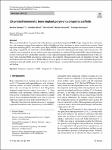Thông tin tài liệu
Thông tin siêu dữ liệu biểu ghi
| Trường DC | Giá trị | Ngôn ngữ |
|---|---|---|
| dc.contributor.author | Bankole, Oladapo | - |
| dc.contributor.author | Abolfazl, Zahedi | - |
| dc.contributor.author | Sikiru, Ismail | - |
| dc.date.accessioned | 2023-04-18T08:02:27Z | - |
| dc.date.available | 2023-04-18T08:02:27Z | - |
| dc.date.issued | 2023 | - |
| dc.identifier.uri | https://link.springer.com/article/10.1007/s00170-023-11344-x | - |
| dc.identifier.uri | https://dlib.phenikaa-uni.edu.vn/handle/PNK/8043 | - |
| dc.description | CC BY | vi |
| dc.description.abstract | This research introduced a new poly-ether-ether-ketone calcium hydroxyapatite (PEEK-cHAp) composite for a convenient, fast, and inexpensive femur bone-implant scaffold with different lattice structures to mimic natural bone structure. Fused deposition modelling (FDM) was used to print a hybrid PEEK-based filament-bearing bioactive material suited for developing cHAp. Using FDM, the same bone scaffold PEEK will be fabricated, depending on the shape of the bone fracture. The scaffolds were examined for in vitro bioactivity by immersing them in a simulated bodily fluid (SBF) solution. Furthermore, in vitro cytotoxicity tests validated the suitability of the composite materials employed to create minimal toxicity of the scaffolds. After spreading PEEK nanoparticles in the grains, the suggested spherical nanoparticle cell expanded over time. | vi |
| dc.language.iso | en | vi |
| dc.publisher | Springer | vi |
| dc.subject | PEEK-cHAp | vi |
| dc.subject | FDM | vi |
| dc.title | 3D-printed biomimetic bone implant polymeric composite scaffolds | vi |
| dc.type | Book | vi |
| Bộ sưu tập | ||
| OER - Kỹ thuật điện; Điện tử - Viễn thông | ||
Danh sách tệp tin đính kèm:

